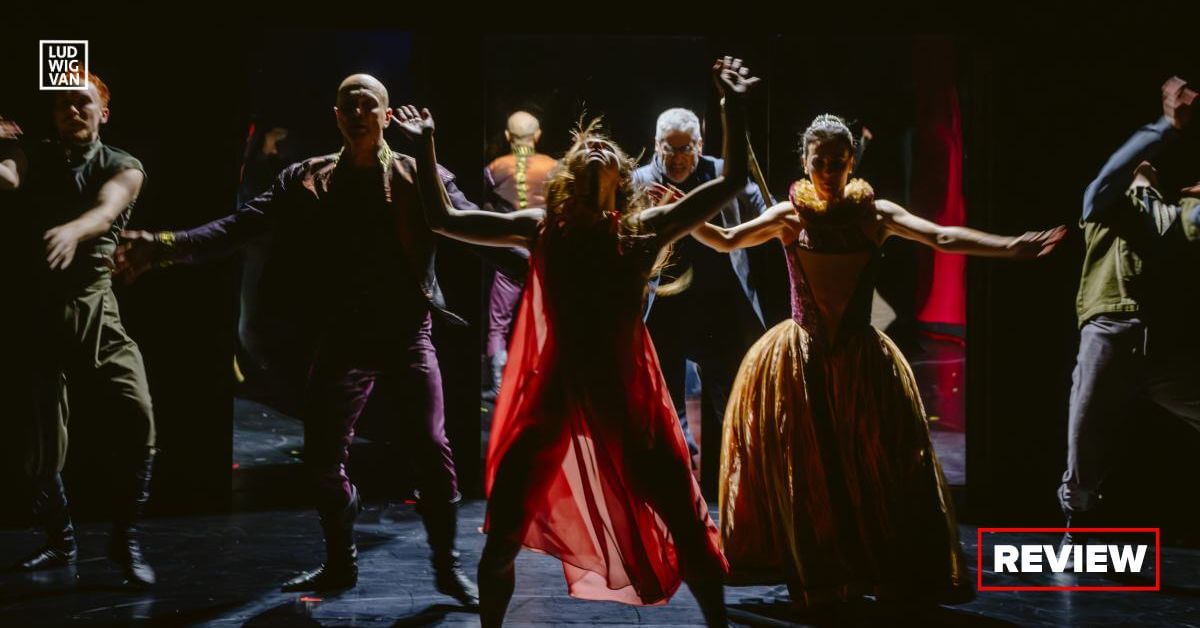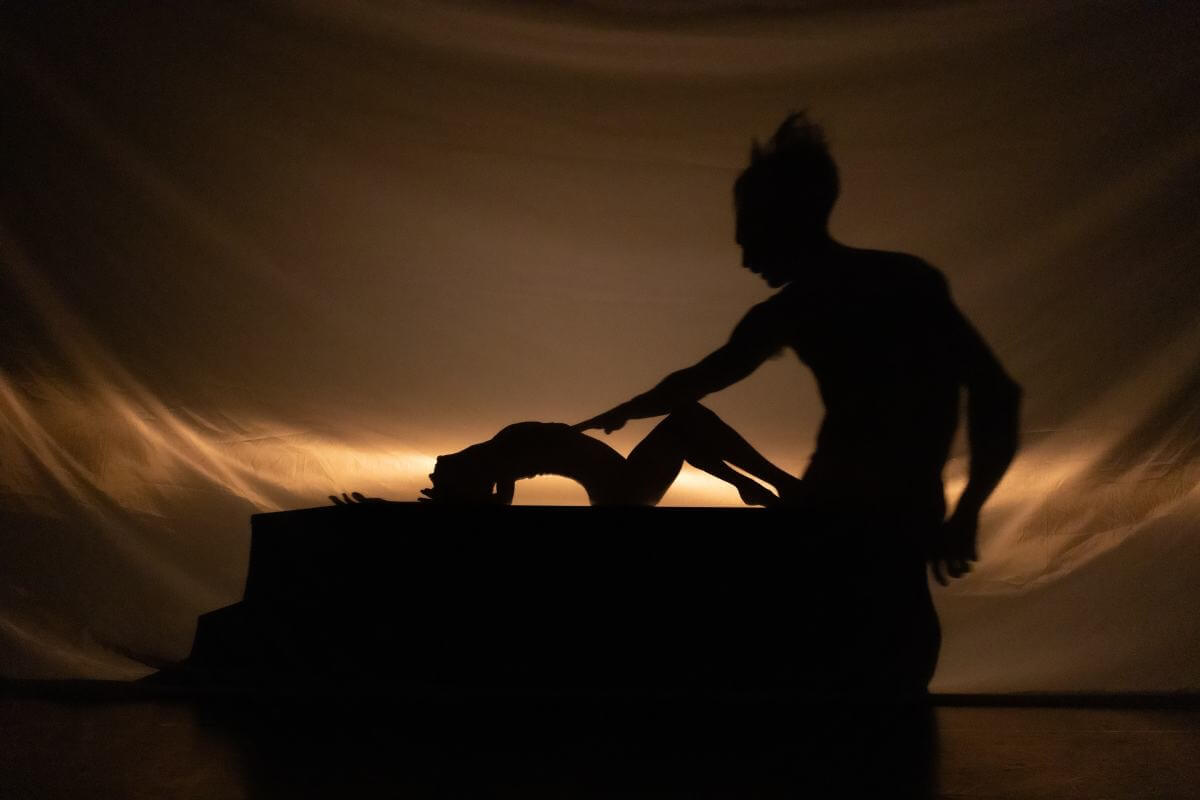
Ex Machina, Côté Danse & Dvoretsky Productions/The Tragedy of Hamlet, Prince of Denmark, designed and directed by Robert Lepage, co-designed and choreographed by Guillaume Côté, Elgin Theatre, closes April 7. Get tickets here.
At the end of The Tragedy of Hamlet, Prince of Denmark, the audience erupted into a standing ovation and prolonged applause, even continuing to clap after the curtain fell, but, alas, I was not among the enthusiasts. For me, this much-anticipated dance drama came up short.
I sincerely hope that the ardent opening night reaction was not just from friends, and that this ambitious show will find its audience. I wish it well, but there is no getting around the fact that for some cognoscenti, such as myself, this dance-through Hamlet will be a disappointment. Thus, I concede that this review, judging from the rapturous opening night response, is a minority report.
The co-creators of Hamlet, Robert Lepage and Guillaume Côté, are Canadian arts royalty. Director Lepage is a theatre visionary, while Côté is a much-acclaimed dancer/choreographer. Frame by Frame, the piece they created for the National Ballet of Canada in 2018 as a homage to film innovator Norman McLaren, was a sensational blending of live action and high tech imagery. After all, Lepage is considered a technology guru throughout the world.
For this dance drama, however, Lepage opted to go low tech, meaning, to utilize the basic bare necessities of theatre, which includes sets, costumes, lighting, and visual effects crafted by human hands. The dance itself, the choreography, was meant to be front and centre, and it certainly is.
Over many scenes, the nine dancers tell the straightforward story of Hamlet as Shakespeare wrote it, with some minor modifications. If Lepage and Côté wanted to make some new statement on the character of Hamlet, or shed fresh insights on the play, that doesn’t happen. This dance drama is a conventional treatment of the material.
Côté’s choreography is very clear in depicting character and action, and for that, he should be commended. Even people who don’t know the plot of Hamlet will easily follow the storyline. There are also some cryptic surtitles that give quotes from the text, which also help set the scene, although some are very cheeky. Just before Hamlet confronts the ghost of his father, the surtitle reads: “Something is rotten in Denmark.”

The problem with Côté’s movement is that it breaks no new barriers in dance. What appears on stage is an incarnation of the ballet you know and love, mixed, at times, with other dance forms. The steps are well put together, and attractive to look at. Nonetheless, while the men display gymnastic virtuosity and the women exhibit sublime grace, I must use the word conventional again. We are not seeing anything really new in terms of cutting edge choreography.
To Côté’s credit, he had to come up with a slew of different pas de deux, matched to character — Hamlet and Horatio, Hamlet and Ophelia, Claudius and Gertrude, Ophelia and Laertes, Ophelia and Polonius, Hamlet and Gertrude — and he did. They all contain serious partnering, including lifts, and are showy enough, but what I think I’m trying to say here, is, that they lack excitement. In fact, the whole dance drama lacks excitement.
The movement unfolds, a story is told, but the drama does not engage on any emotional level. As an audience member, I was a mere observer who was never invested in the plight of the characters.
There is, however, much to recommend about the production in terms of design, for which both Lepage and Côté are credited as co-creators. Scenically, this Hamlet is quite beautiful.
The stage is swathed in red velvet drapes, some of which can move around and change shape. The three chandeliers bathe the stage in a warm golden glow which evokes past times, courtesy of lighting maven Simon Rossiter. There are wooden platforms that, in this low tech world, break apart or come together to transform into tables, desks, beds, coffins, and the like, but with each iteration, they have a regal air about them. Even the chairs cast a palatial aura, covered as they are in plush upholstery.
In other words, there is a luxurious veneer over everything, and this includes the absolutely gorgeous costumes by Michael Gianfrancesco and Monika Onoszko. The fabrics are rich in texture, whether it be Hamlet’s black, skin-tight body suit and boots, or Gertrude’s ornate period gowns. In terms of production values, this show is a class act.
Another huge plus is composer John Gzowski’s magnificent original score that could stand on its own as a wonderfully evocative piece of music.
Each scene has an identifying melody using different combinations of instruments, although the cello predominates. There doesn’t seem to be any repeats. Each vignette is musically unique, running the gamut from baroque dance music celebrating the union of Claudius and Gertrude, to underlining the reflective solos given to almost every one of the characters. Whether the playful high jinks of Rosencrantz and Guildenstern, or the percussive tension of the Hamlet/Laertes duel, Gzowski’s score fits the dance like hand to glove.
This Hamlet also showcases some dazzling stage imagery, but for some reason, it did not feel like it was enough to give this production real pizazz. Perhaps, because it was Lepage who was a creator, I wanted more. Nonetheless, when one of these imaginative visual effects does connect, it is great theatre.
Take for example Ophelia’s drowning scene. The dancer is placed against a rippling, powder blue cloth, and unseen hands from behind the curtain, lift her in the air so it looks like she is actually in the water.
Then there’s the Ghost’s description of his murder, which is cleverly performed as silhouettes behind a bed sheet. As for the play that will catch the conscience of the king? Lacking a troupe of actors, Hamlet and Horatio perform the murder of Hamlet’s father using masks, but the kicker is, the faces are on the back of their heads so they are actually dancing backwards.

Overall, I feel that the show needs more of these eye candies to offset the dance. In fact, as silly as it sounds, this dance drama has too many moments of pure dance.
There is also a structural problem. To allow for set changes, the main curtain closes, and Côté has provided choreography in front as a cover. While the scenario of the movement is always logical, for example, Hamlet going off to England with Rosencrantz and Guildenstern, after a time, the repetitive opening and closing of the curtain becomes routine. Curtain close, equals, front of curtain action. There is no change-up in format to relieve the predictability factor, and so the dramatic spine of the show falls flat.
And then there is the very odd ending, with Horatio, the only survivor, performing an angst-ridden solo in silence after Hamlet’s death. It just doesn’t feel right. What kind of statement is this solo making in relation to the play? Admittedly, Shakespeare didn’t end with Hamlet’s death either, but while Prince Fortinbras’ arrival is somehow acceptable in the original, this ending just doesn’t work for me.
On a happier note, this show is bursting with talent. The entire cast is superbly gifted while being age appropriate. There is some wicked dancing being performed by a company that can also act up a storm. It is in the quality of the ensemble, where this dance drama finds its greatest success.
Côté cast himself as Hamlet, but even though he’s 41, he can still toss off bravado dance moves. He’s also very handsome and looks every inch a prince. The one thing I didn’t get from him was madness, although Côté projected Hamlet’s many moods very well, along with his differing relationships with various characters.
Casting a woman, the formidable dance wizard Natasha Poon Woo, as Hamlet’s friend Horatio, was a stroke of genius, her being a softer, more cheery foil for the morose Hamlet. She is also able to execute lightning fast, energetic movement in contrast to Hamlet’s more introspective nature. Poon Woo is a superb dance interpreter.
The great Greta Hodgkinson, late of the National Ballet, and the equally great Robert Glumbek of ProArteDanza, give outstanding performances as Gertrude and Claudius. Both are 50, but still move with stated elegance. As well, they both are capable of producing serious dancing, along with radiating vivid character portrayals. The lustful chemistry between the two of them was palpable.
The Polonius family is headed by 70-year-old Bernard Meney, who is suitably fussy and bureaucratic, but loving with his children. Carleen Zouboules, who is a consummate ballerina, presented Ophelia as a delicate vulnerable flower, while Lukas Malkowski as Laertes is simply a phenomenal dancer and a virtuoso of movement.
As for Rosencrantz and Guildenstern, Connor Mitton and Willem Sadler, respectively, perform their lighter roles with an energetic flair and devil-may-care attitude. Côté’s choreography for them is reminiscent of the jolly ensembles for Romeo, Mercutio and Benvolio in various Romeo and Juliet ballets. Like Malkowski, they display technique up the whazoo.
As I said before, I want people to embrace this show, and I think they will, because it looks good and tells its story well. Alas, for me, this Hamlet did not meet my expectations, but then, I’m not the general public.
Are you looking to promote an event? Have a news tip? Need to know the best events happening this weekend? Send us a note.
#LUDWIGVAN
Get the daily arts news straight to your inbox.



